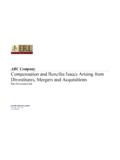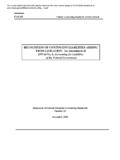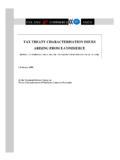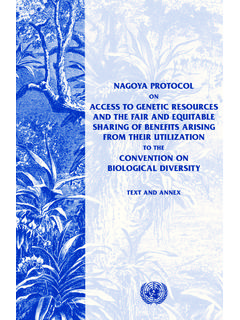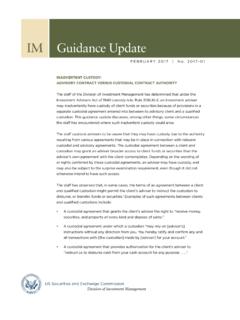Transcription of Hazards arising from the conveyance and use of gas from ...
1 Health and Safety Executive Hazards arising from the conveyance and use of gas from Non- conventional Sources (NCS) Prepared by GL Noble Denton for the Health and Safety Executive 2011 RR882 Research Report Health and Safety Executive Hazards arising from the conveyance and use of gas from Non- conventional Sources (NCS) Diane Broomhall Glyn Morgan Martin Brown Luisa Shelenko Tim Illson Angie Siddle Yoke Ling Lee Julie Truong Martin Maple GL Noble Denton Holywell Park Ashby Road Loughborough Leicestershire LE11 3GR The Health and Safety Executive (HSE) recognises that there is increasing interest in the use of non- conventional source (NCS) gases and that conveyance of the gas from the source to the end user will be through the existing natural gas grid.
2 All gas transported and used has to comply with the Gas Safety (Management) Regulations [GS(M)R] and this raises questions with regard to the suitability of the NCS gas within the network and the possible additional Hazards that may result over and above those associated with natural gas. The HSE commissioned this study to review the available data on NCS gas composition to support assessment of Hazards and risks associated with the introduction of NCS gas into pipeline networks. This report covers the following aspects: nCollation of data on composition for a range of NCS gas types and sources, including both bulk gas components and contaminants. nSummary of NCS gas clean-up processes and their performance with regard to removal of contaminants.
3 NImpact of NCS gas composition on network materials, combustion/utilisation equipment and emissions. The majority of compounds found in NCS gas are similar to those found in natural gas and thus pose no greater risk to the integrity of the pipeline and downstream equipment, however, siloxanes, high levels of oxygen and highly odiferous compounds need further study. This report and the work it describes were funded by the Health and Safety Executive (HSE). Its contents, including any opinions and/or conclusions expressed, are those of the authors alone and do not necessarily reflect HSE policy. HSE Books Crown copyright 2011 First published 2011 You may reuse this information (not including logos) free of charge in any format or medium, under the terms of the Open Government Licence.
4 To view the licence visit , write to the Information Policy Team, The National Archives, Kew, London TW9 4DU, or email Some images and illustrations may not be owned by the Crown so cannot be reproduced without permission of the copyright owner. Enquiries should be sent to ACKNOWLEDGEMENTS GL would like to gratefully acknowledge the assistance of several companies and individuals that provided measurement data and information related to their work on NCS gas. In particular GL would like to mention the help from National Grid, Centrica, Mark Bugler, John Baldwin, Thorsten Ahrens, Frank Graf, Bj rn Goffeng, Glenn Mercer, Andrew Dicks, Sandra Esteves, Charles Banks, Jan Stambasky. ii CONTENTS 1 Introduction 1 2 Compliance Requirements 3 3 NCS Gas Quality Data 7 Collation of available data 7 Gas sampling and analytical techniques 7 Biogas 8 Landfill Gas 8 Coal mine, coal bed.
5 Shale gas and underground gasification 8 SNG from biomass source 8 NCS summary data 8 4 Gas Clean-up and Removal of Contaminants from NCS Gas 13 Biogas and landfill gas clean-up processes 14 SNG from gasification clean-up processes 16 Coal mine/coal bed gas clean-up processes 18 5 Possible Impacts of using NCS Gas 19 Assessment of the effects on metallic materials in pipeline 19 infrastructure Assessment of the impact of elevated oxygen concentration 25 Assessment of the effects on non-metallic materials in pipeline 28 infrastructure NCS gas and non-metallic materials 31 Impact on leakage detection 34 Combustion equipment and processes 35 Atmospheric emissions 42 Impacts on health -routes to harm 44 6 45 Mitigation of Potential Impacts iii 7 47 NCS Gas Quality Requirements Outside of the UK Sweden 47 The Netherlands 48 Germany 49 Switzerland 49 Austria 50 California (USA)
6 50 8 Conclusions 53 9 Recommendations for Further Studies 57 References 59 Glossary 61 Appendix 1 Reference List for Gas Quality Data 63 iv E X E C U TI V E S U MMA R Y This report provides information for the UK Government Health and Safety Executive (HSE)including sufficient data to undertake an assessment of Hazards and risks associated with the introduction of non- conventional source (NCS) gas into the existing national gas network.
7 This will enable HSE to adequately assess any safety case submitted under the Gas Safety (Management) Regulations (GS(M)R) and provide guidance, procedures and processes toensure compliance and continued safe operation of the gas network. This report covers the following :1. Collation of data on composition for a range of NCS gas 2. Summary of NCS gas clean-up processes 3. Impact of NCS gas composition on network materials 4. Impact of gas composition on combustion equipment 5. Impact of gas composition on emissions The collation of compositional data showed that there are significant differences between NCS gas from different sources. Farm biogas has much higher concentrations of hydrogen sulphide (H2S) and micro-organisms than waste water biogas and also contains traces of pesticides and water biogas contains siloxanes and odiferous compounds such as terpenes and aldehydes whereas farm biogas contains ammonia (NH3).
8 Waste water biogas can also contain low levels of particulate matter and metals including arsenic. Landfill gas composition is source dependent. Raw gas from domestic waste is more likely to contain odiferous compounds such as terpenes and carbonyls. Raw gas from industrial waste contains the highest levels of arsenic. The total sulphur content of raw landfill gas is approximately 50% H2S, 50% organic sulphides and thiols so only removing H2S will leave total sulphur levels above those imposed by GS(M)R. All sulphur-containing compounds willneed to be removed or reduced in concentration to meet the overall gas quality requirements. Clean-up technologies are available to remove or reduce the minor and trace components of biogas to result in GS(M)R compliant gas that can be supplied into gas networks.
9 However,the oxygen and siloxane may need further processing to reduce the concentrations to moreacceptable levels. Clean-up technologies will be able to remove or reduce trace componentsof landfill gas but there is concern over organic halides, the performance of siloxane removalequipment, the presence of a much wider range of contaminants, the presence of pharmaceuticals and the presence of micro-organisms. Synthetic natural gas (SNG)production and clean-up technologies will be able to produce a gas suitable for injection intothe natural gas grid. However, to date there is only limited information on the performance ofSNG production and there is a need for further studies to demonstrate the overall process andmeasure the concentration of trace components.
10 Coal bed and coal mine methane fuels can be processed and cleaned-up to produce a gas suitable for grid injection. However, the measurements on trace components are very limited and further studies are required. The majority of materials degradation risks associated with the introduction of NCS gasesinto the metal pipelines of the gas distribution network are dependent on the presence of water. It is thus crucial to maintain sufficient dehydration of NCS gases before adding to thenatural gas network. The main risk to the gas network is the reliance on the NCS gas supplier v to maintain the gas processing units and monitor the










